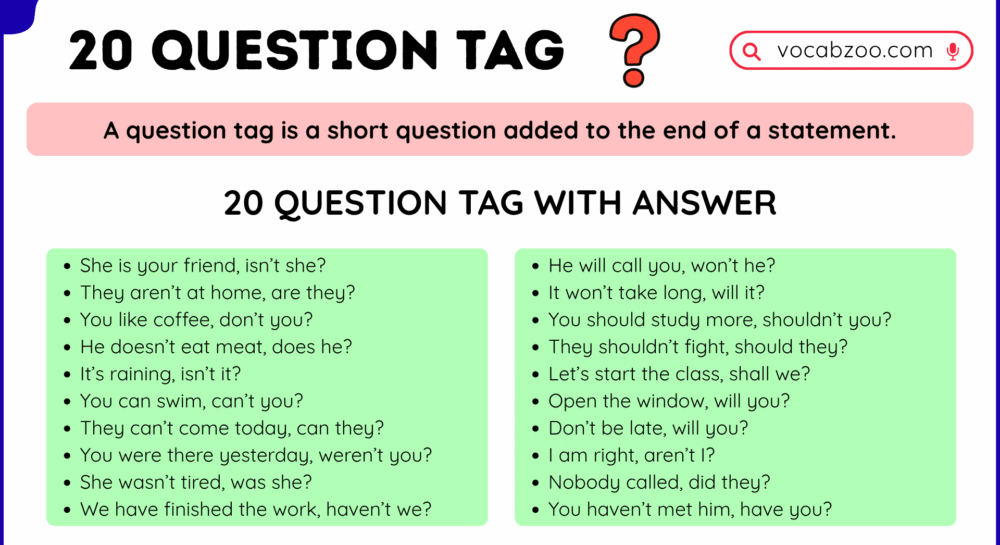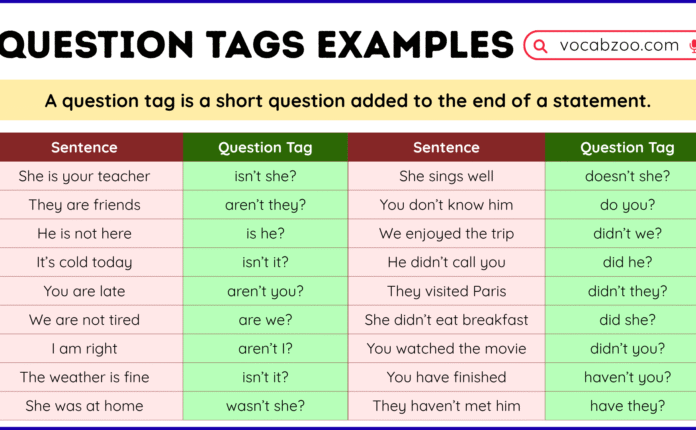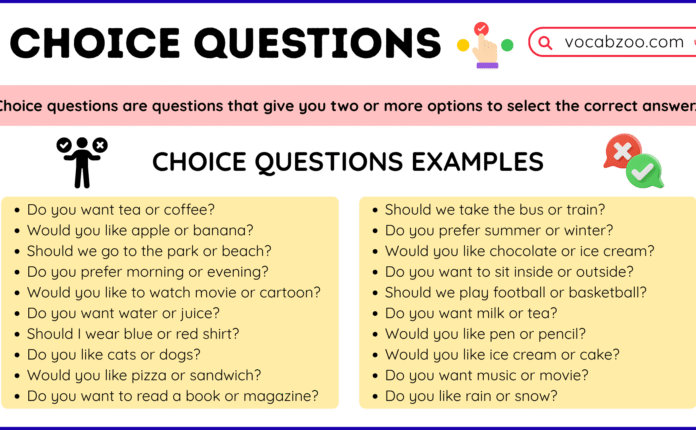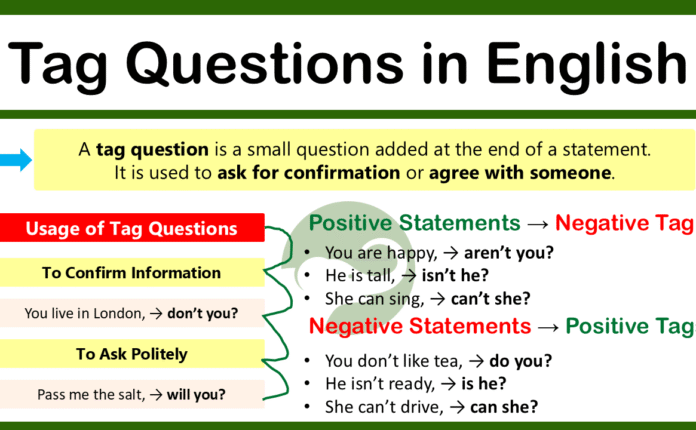Learning question tags is a fun and useful part of English grammar. They help make your conversations more natural and friendly. Whether you’re talking, asking, or confirming something, question tags can make your English sound smooth and fluent. In this article, you’ll learn what question tags are, how to use them correctly, and see 20 easy examples with answers.
What are Question Tags?
A question tag is a short question added to the end of a statement. It turns a simple sentence into a question that checks information or asks for agreement.
It’s used to make your sentence sound polite or to confirm something.
Example:
- You’re a student, aren’t you?
- She can drive, can’t she?
How Question Tags Work
A question tag is made with an auxiliary (helping) verb like is, are, have, can, do, etc., and a pronoun (I, you, he, she, it, we, they).
Basic Rules:
| Statement Type | Question Tag Rule | Example |
|---|---|---|
| Positive Statement | Use negative tag | You are a teacher, aren’t you? |
| Negative Statement | Use positive tag | You aren’t busy, are you? |
| With I am | Use aren’t I in tag | I am late, aren’t I? |
| With Let’s | Use shall we | Let’s go for a walk, shall we? |
| With Imperatives | Use will you / won’t you | Open the door, will you? |
20 Question Tag with Answer
Here are 20 common question tag examples used in daily English conversation:
- She is your friend, isn’t she?
- They aren’t at home, are they?
- You like coffee, don’t you?
- He doesn’t eat meat, does he?
- It’s raining, isn’t it?
- You can swim, can’t you?
- They can’t come today, can they?
- You were there yesterday, weren’t you?
- She wasn’t tired, was she?
- We have finished the work, haven’t we?
- You haven’t met him, have you?
- He will call you, won’t he?
- It won’t take long, will it?
- You should study more, shouldn’t you?
- They shouldn’t fight, should they?
- Let’s start the class, shall we?
- Open the window, will you?
- Don’t be late, will you?
- I am right, aren’t I?
- Nobody called, did they?
Uses of Question Tags
1. For Confirmation:
You’re coming tomorrow, aren’t you?
(Used to confirm something you believe is true.)
2. For Checking Information:
She lives here, doesn’t she?
(Used to make sure your information is correct.)
3. For Politeness or Softness:
Pass me the salt, will you?
(Used to sound polite in requests.)
4. For Surprise or Emotion:
You won the prize, didn’t you!
(Used to show surprise or excitement.)
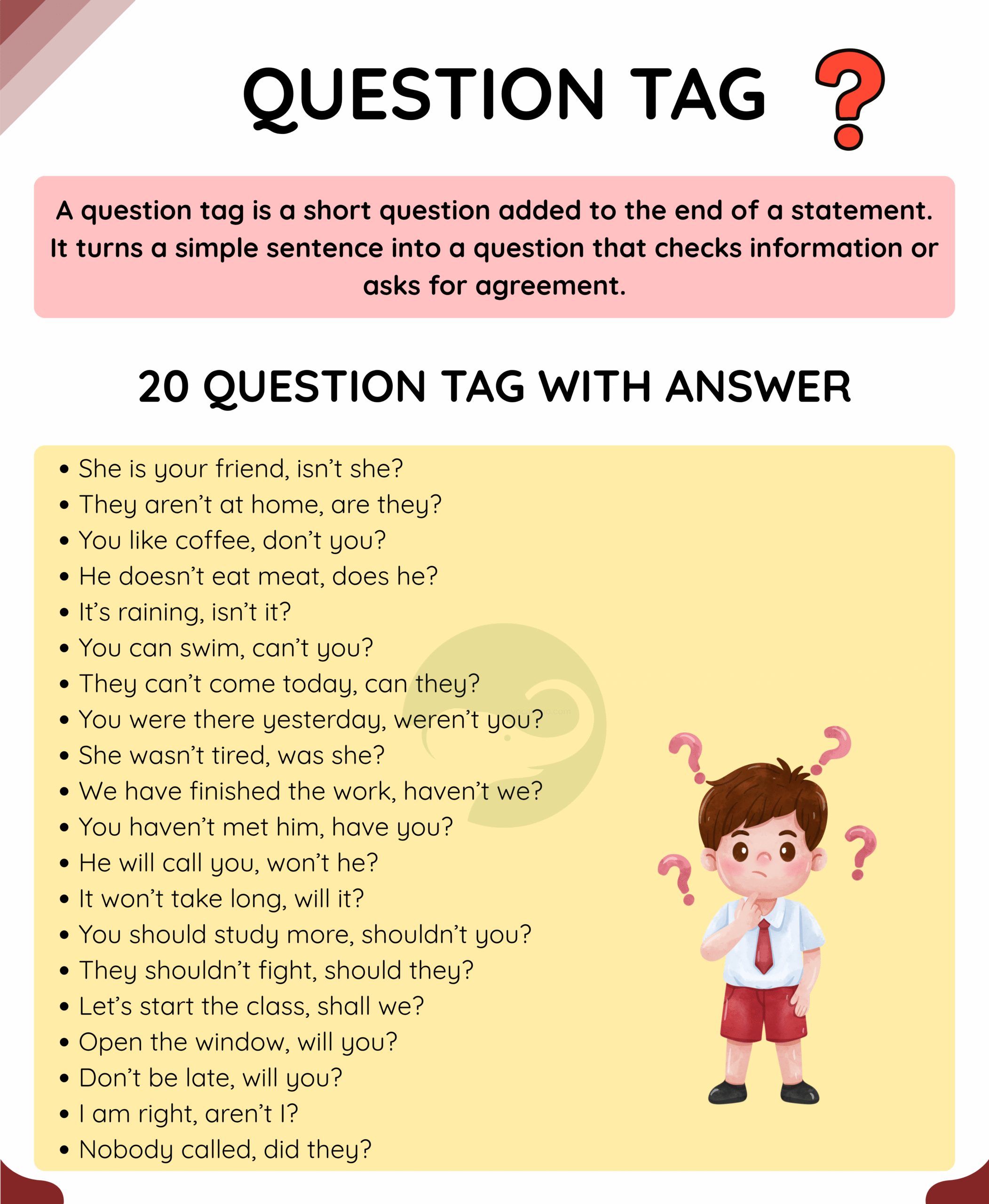
Tips to Remember
- Use opposite meaning in the tag (positive → negative, negative → positive).
- Always use the helping verb from the main sentence.
- Use pronouns in the tag, not full nouns.
- Use correct intonation:
Rising tone → for real questions.
Falling tone → for confirmation or politeness.
Question tags make English sound natural, friendly, and interactive. They are easy to learn with practice and can improve your spoken English quickly. Start using these 20 examples in your daily talks and you’ll sound more fluent and confident in no time!
FAQs about 20 Question Tag with Answers
What is a question tag in English grammar?
A question tag is a short question added at the end of a statement to confirm or check information. For example, You’re coming, aren’t you?
How do you form a question tag?
To form a question tag, use an auxiliary verb (like is, are, can, do) and a pronoun. If the statement is positive, the tag is negative, and vice versa.
What are some common examples of question tags?
Here are some common examples:
It’s cold, isn’t it?
You like music, don’t you?
They can’t drive, can they?
Why are question tags used in English?
Question tags are used to make speech polite, confirm facts, or ask for agreement. They help make conversations more natural and friendly.
What are the basic rules for using question tags?
The rules are simple:
Use the opposite form (positive → negative, negative → positive).
Use the same helping verb as in the sentence.
Always end with a pronoun, not a noun.
Read More
